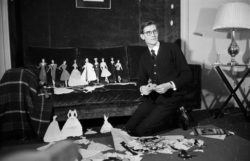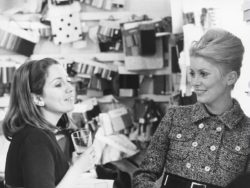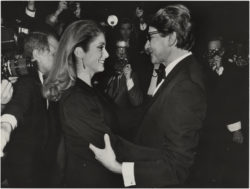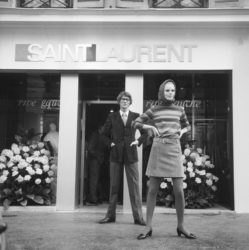The Saint Laurent women
Yves Saint Laurent was always very close to women. Models, actresses, authors, artists, friends and collaborators―they were all essential to his inspiration and his work.
As the couturier said in 1997: “Women and I love each other. My collections are love stories.”
Chapter 1
The family circle

In Algeria, where he was born, Yves Saint Laurent was raised in a feminine environment, surrounded by his mother, Lucienne Mathieu-Saint-Laurent, his maternal grandmother, his great aunt and his two sisters.
An avid reader of fashion magazines, such as Vogue, L'Illustration and Le Jardin des Modes, he was fascinated by his mother, who “spent most of her time dressing,” and by the ensembles she would wear from one evening to the next.

Yves has always been interested in fashion. At three, he would cry if he didn't like my dress. [...] He did the sets for the Yacht Club and for receptions, as well as the costumes for the dance school.Lucienne Mathieu-Saint-Laurent

Growing up in an environment that inspired him, Yves Saint Laurent’s early creative streak first became apparent in the paper dolls that he would dress up to the delight of his first audience, his two sisters Michèle and Brigitte. Born in 1942 and 1945, they were close to their elder brother, with whom they maintained a very tight bond. To further entertain them, Yves would invent adventure stories that took place in an imaginary world into which they would happily enter.
Every time I design a collection, I rediscover my childhood, I commune with it.Yves Saint Laurent
Chapter 2
The idolized couturiers

In 1968, seven years after the launching of his own fashion house, Yves Saint Laurent was referred to by Gabrielle Chanel as her heir apparent, “because someday someone will have to continue what I’ve done.” The legendary couturier, who revolutionized the feminine wardrobe by freeing it from the corset and by offering the comfort of trousers, was gradually withdrawing from the fashion world, which had been overtaken by the events of May ’68 and the winds of modernity inspired by the youth movement and street fashion, something which she had trouble understanding.
Yves Saint Laurent, on the other hand, was inspired by precisely this revolutionary atmosphere that led him to create the wardrobe of the modern woman. In the spirit of what Gabrielle Chanel had accomplished at the beginning of the 20th century, he sought to free women from the clothing that hindered them. While offering them a modern sense of comfort and elegance, he would design a wardrobe that would place women on a par with men.
Chanel gave women freedom. Yves Saint Laurent empowered them.Pierre Bergé
Yves Saint Laurent also greatly admired the work of the renowned couturier Elsa Schiaparelli, who had been very close to the Surrealist group during the years between the two World Wars. Her oeuvre, nurtured by her friendship and collaborative work with artists and writers such as Salvador Dalí and Jean Cocteau, clearly stood apart from the neoclassical orientation of fashion at the time.

Yves Saint Laurent and Elsa Schiaparelli shared a passion for the ornamental embellishment of clothing and for daring colors such as the “shocking pink” so associated with the latter. Saint Laurent would pay tribute to her work in several of his designs, such as in his “broken mirror” jacket, a motif that Schiaparelli had used in 1935 for an embroidered jacket.
Chapter 3
The fashion models of the early years

In 1955, when he began working at Christian Dior at the age of 18, Yves Saint Laurent met Victoire Doutreleau, the couture house's star model.
She quickly became Yves Saint Laurent’s favorite model, despite not having the measurements usually associated with runway models―she was smaller and less slender. And yet it was her way of wearing and embodying the garment that made such an impression on the young couturier. It must have been then that he realized the importance of designing directly on a fashion model, who not only wears the garment but moves with it and brings it to life.
Victoire followed Yves Saint Laurent when he founded his own fashion house in 1961.
From one collection to another, the same image presents itself to me: that of Victoire, the sublime model and marvelous muse.”Yves Saint Laurent

Following in the footsteps of Victoire, another model caught the designer’s attention. Red-haired, skinny and with a slightly androgynous face, Danielle Luquet de Saint Germain was 19 when she introduced herself to Yves Saint Laurent. Her carefree attitude and way of presenting herself made her seem, in the couturier’s eyes, the embodiment of modernity and energy of the street that the couturier was drawn to.
Danielle Luquet de Saint Germain played the role of muse for many of the couturier’s iconic garments: It was with her in mind that he created his first tuxedo-inspired smokings and his first safari jacket, as well as the infamous transparent black blouse that caused a scandal after Danielle paraded it topless down the runway.
Chapter 4
The close friends
Yves Saint Laurent met one of his closest friends, Betty Catroux, in a nightclub in 1967. They immediately become inseparable. Betty Catroux became his double, his twin, his accomplice. Together, they cultivated a “taste for everything seedy” and for all that Parisian nightlife had to offer.

Along with Betty Catroux, Louise de La Falaise was one of Yves Saint Laurent’s closest friends. Born in England in 1948, she was the daughter of a French aristocrat and an Anglo-Irish woman. When they met in 1968, Yves Saint Laurent was immediately charmed by this radiant young woman. At the time, she would dress in flea market finds and create for herself a look that was as elegant as it was original.
Yves Saint Laurent went everywhere with Betty and Loulou: They would be seen together at runway shows, parties, trips overseas―they were an inseparable trio.

Chapter 5
The colleagues

As well as being a close friend, Loulou de la Falaise worked alongside Yves Saint Laurent at the couture house. She entered the couturier’s private workspace―the Studio as it was called―in 1972, where she remained beside the couturier for thirty years. She was quickly put in charge of accessories, which she preferred to be oversized and colorful, and was also responsible for the knitwear line.

Press officer for the SAINT LAURENT rive gauche ready-to-wear line from 1968, Clara Saint took an active part in the life of the fashion house. She was a close friend of Yves Saint Laurent and Pierre Bergé, and introduced them to Andy Warhol and Paloma Picasso.
Passionate about cinema, Clara participated in the production of several advertising campaigns for Yves Saint Laurent fragrances, as the famous Opium, launched by the house in 1977.

Another permanent presence in Yves Saint Laurent’s Studio was Anne-Marie Muñoz-Yagüe. She previously had worked at Christian Dior, arriving there in February 1951, where she discovered the ins and outs of haute couture. It was there that she met Yves Saint Laurent in 1955.
Their paths briefly parted when Yves Saint Laurent left Dior. Anne-Marie Muñoz went on to work at Guy Laroche for a year, before joining the House of Yves Saint Laurent in 1963 as director of the Studio. She oversaw the entire creative process for more than 150 haute couture and ready-to-wear collections at the couture house until its closure in 2002.

“The couture house is like an anthill bursting with energy, in which nearly two hundred people work, mostly women. A deep complicity existed between Saint Laurent and everyone working there, as reflected by what Madame Catherine, a former workshop director had to say: “He does not need to speak. I understand before he speaks.”
Under the leadership of the workshop directors, Yves Saint Laurent’s seamstresses earned his deep trust to realize his most extraordinary creations, as he made clear in an interview:
“Beside me [...] there are also the seamstresses, those who work by hand and who are the holders and last custodians of the secrets of haute couture [...]. Apart from them [...] there are the women who work at the machines, day and night. I sometimes make them destroy everything they’ve done. I would never offend them by letting them work on something without believing in it myself.”
English subtitles are available through the settings menu in the player
Chapter 6
The Yves Saint Laurent spirit

Among the women close to Yves Saint Laurent, there were those who embodied his creative spirit, obviously through the clothes they wore, but also in their attitude.
Catherine Deneuve was twenty-two when she first met Yves Saint Laurent. When she learned that she would be presented to the Queen of England, the young woman chose Yves Saint Laurent to dress her. In 1966, the actress became the godmother of sorts of the first SAINT LAURENT rive gauche ready-to-wear boutique, an embodiment of the youth and modernity that Yves Saint Laurent sought in his revolutionary clothing line.
A faithful friend to the end, Catherine Deneuve attended all the important anniversary celebrations of the couture house, up until its very last runway show, held at the Pompidou Center on January 22, 2002, where she closed the evening by singing with Laetitia Casta, “Ma plus belle histoire d’amour” (My Most Beautiful Love story) by Barbara.

Meeting Pablo Picasso's youngest daughter, Paloma, was an “aesthetic jolt” for Yves Saint Laurent. She embodied the new face of an anti-establishment freedom that the designer was forever pursuing in his work.
Almost immediately, Paloma gave him the impetus to become more audacious, to “kick the anthill” as it were. It was her “flea market” look, at once elegant, daring and innovative―composed of turbans, fur boleros and dresses from the thirties and forties―that would inspire Yves Saint Laurent when designing his Summer 1971 collection, which came to be known as “La collection du scandale” (The Scandal Collection).

As mentioned above, Betty Catroux was not only Yves Saint Laurent’s close friend, but also the embodiment of the Saint Laurent style. Even before they met, she already had an affinity for men's clothes, in which she felt the most herself. Betty Catroux played an essential role in the work of Yves Saint Laurent, who for several years had defined his own style by drawing on the codes of the masculine wardrobe. He kept the cut, comfort and practicality of men’s clothing while adjusting them to a feminine silhouette, combining simplicity and elegance.

Chapter 7
The fashion models

When designing a couture garment, the presence of a model is essential.
Unlike Gabrielle Chanel who worked on inanimate mannequins, Yves Saint Laurent could not design without a live fashion model beside him, as he felt that they were integral to giving life to the garment. Very often, it was with particular fashion models in mind that Yves Saint Laurent designed his collections.
Yves Saint Laurent was the first couturier to include black models in a runway show. Several, such as Katoucha Niane, Mounia Orosemane and Amalia Vairelli, would go on to become his favorite fashion models. He appreciated how the models’ skin tones complemented the colors he used in his fabrics.
One of the models he frequently used, Amalia Vairelli, worked both as an in-house model and in runway shows, where she was often presented with “The Heart,” a sumptuous piece of jewelry, considered a sort of fetish by the couturier, which would be worn by his favorite model.

When I see a fashion model, I know what I'm going to design for her. It's like love at first sight. I fall in love.Yves Saint Laurent

The Heart was also often worn by Laetitia Casta, who met Yves Saint Laurent in 1996. Despite not having the slender silhouette typical of models employed by the couture house, Laetitia Casta very quickly became one of the couturier’s favorite models, the one he chose to wear, on multiple occasions, the wedding dress that closed every runway show. Yves Saint Laurent nicknamed her his "bird of paradise," and designed a dress for his Spring-Summer 2000 collection with her in mind, fashioned entirely with feathers from this exotic bird.
Chapter 8
The clients

Beginning with the very first collection presented by the couture house, a number of celebrities attended the young couturier's runway shows and became his clients. Seated in the front rows, they included some of the most prominent members of society at the time, such as Marie-Hélène de Rothschild and the Countess de Ribes, but also international celebrities such as the Duchess of Windsor, Princess Grace of Monaco, Elizabeth Taylor and Lauren Bacall. Later, several wives of leading French politicians would also choose to dress in Yves Saint Laurent, including Claude Pompidou, Danielle Mitterrand, Monique Lang and Bernadette Chirac.
Among the rich and famous that gravitated to Yves Saint Laurent, the American Nan Kempner would become one of the couture house's most loyal clients. She met Yves Saint Laurent at Dior in 1958. The elegance that characterized her style earned her praise from Diana Vreeland, the renowned American fashion editor: “There is no such thing as a chic American woman. The only exception is Nan Kempner.”
Over the course of her life, Nan Kempner assembled a wardrobe that included a thousand dresses, three hundred and seventy-six bearing the label of her favorite designer. She said of Yves Saint Laurent: “I don't believe there is a single woman in the world who has not been influenced by him.”

Charlotte Aillaud, an icon of the vibrant Saint-Germain-des-Prés social scene and sister of Juliette Gréco, met Yves Saint Laurent in 1964 through Françoise Sagan. She would become one of his most loyal clients, as shown by her letters to the couturier kept by the Musée Yves Saint Laurent Paris: “My very dear Yves, just to tell you how moved I was the other evening watching these marvels from your wonderful universe paraded before me. Watching this magical farandole, I was flooded with memories, and Gilberte's daughter at the ball from In Search of Lost Time came to mind: ‘I found her beautiful, she looked like my youth.’ I embrace you as I love you: deeply.”
Chapter 9
The artists
A number of women artists also played an important role in the work of the couturier. They allowed him to pursue his interest in the arts and the world of entertainment.
Yves Saint Laurent maintained a special bond with Claude Lalanne, the only artist with whom he collaborated with on a collection. The couturier asked her to make a set of “imprint” accessories for his Fall-Winter 1969 collection. Other jewels designed by her would follow, as well as helmets and headdresses inspired by plant motifs dear to Claude Lalanne. Their collaboration lasted several years until 1983.
While working at Dior in 1956, Yves Saint Laurent met Roland Petit’s partner, the dancer Zizi Jeanmaire. They bonded immediately and quickly became close friends.

Yves Saint Laurent created extravagant feather costumes for her, fulfilling a desire to design for the stage that had been with him since adolescence: “In a music hall, everything is there. One only needs three things to conjure up an entire world. With a bundle of black feathers make a big hat. Then perch it on a tall, naked black girl, and when she arrives on stage, let it become nothing less than a coup de théâtre [...] And the music hall, even more so than the theater, is life turned upside down. Poor materials can be made sumptuous and vice versa.

Yves Saint Laurent also designed stage outfits for the singer Sylvie Vartan, Johnny Hallyday’s companion. He made several outfits for her, including a golden jumpsuit for her performance at the Olympia Theater in 1972. It was not only a very sensual garment, but also comfortable to wear, so much so that the singer continued to wear it on television and on tour after Yves Saint Laurent offered it to her: “In general, on stage, it is important to avoid relaxed clothing in favor of more structured creations. A designer must adapt his work knowing this. The most beautiful haute couture dress will not necessarily serve as a good stage costume. Saint Laurent was well aware of this.”



Chapter 10
The women authors

Yves Saint Laurent was close to several women of letters throughout his life.
As a young man, he met Françoise Sagan. It was she who, in 1967, urged him to publish, through the Tchou publishing house, his album of the adventures of La vilaine Lulu, which Yves Saint Laurent began drawing ten years earlier while still working at Dior.
For the most part, they would end up meeting at social events to which they both had been invited. They would speak little to each other but were “united” by their similar lives, which they felt were defined by “terrifying burdens and responsibilities, incompatible with our idea of what life should be and by our very nature.” In 1980, in an article she published on Yves Saint Laurent, Sagan said, “I knew [...] that he was a shy, secretive, talented and headstrong person. I would go on to learn that he was also lucid, passionate, uncompromising and generous.”

In 1965, Yves Saint Laurent, who had done stage designs for the Renaud-Barrault theatrical company, designed the costumes for a play by Marguerite Duras, Entire Days in the Trees. He admired this woman of letters of whom he said, “She is undoubtedly the greatest French writer of our time. Her universe, her world view and lucidity speak to me. Rarely has one written about women with such emotion and sensuality.”
The admiration is mutual. Marguerite Duras said of him, “I have never ceased to see him as a writer. And however removed from language his work may seem, I have never seen it as distinct from writing. He sees everyone as if the person before him were an entire world, and that's when he takes control of you. [...] He sees things you don't know about yourself.”
Duras also wrote about the launch of the SAINT LAURENT rive gauche ready-to-wear line in 1966, which for her solved the problem of elitism posed by haute couture.

L’admiration est réciproque puisque Marguerite Duras dit de lui : « Je n’ai jamais cessé de le voir comme un écrivain. Et si loin des mots que puisse paraître son travail, je ne l’ai jamais séparé de l’écriture. Il voit chacun comme étant le monde entier et c’est dans cette situation-là qu’il se l’approprie. (...) Il voit de vous ce que vous ne savez pas que vous avez. », Marguerite Duras.
Duras commente également le lancement de la ligne de prêt-à-porter SAINT LAURENT rive gauche, en 1966, qui pour elle résout le problème de l’élitisme que posait la haute couture.

As the ultimate tribute to the emancipation of women and to their equality with men, Yves Saint Laurent designed the costume worn by Marguerite Yourcenar, the first woman to be admitted to the Académie Française. She was elected a member of the Academy on March 6, 1980, and entered the building on January 22, 1981, wearing a velvet houppelande tunic specially designed by Yves Saint Laurent for the occasion.
“Madam, it is a great joy to welcome you to this old and illustrious house where you find yourself, certainly not the first to enter it, but the first of your sex to do so […] a peaceful yet vibrantly revolutionary moment, which you manifest, on your own, as one of the most significant events that fill our long and glorious history. I will not shy away from saying, Madam, that it is not because you are a woman that you are here today: it is because you are a great writer.” ― Jean d´Ormesson on the occasion of Marguerite Yourcenar's admission to the Académie Française, 1980.
The costume Yves Saint Laurent designed for Marguerite Yourcenar contributed to her “stunning entrance” at this historic event, in the words of the literary and theatrical critic Matthieu Galey.














